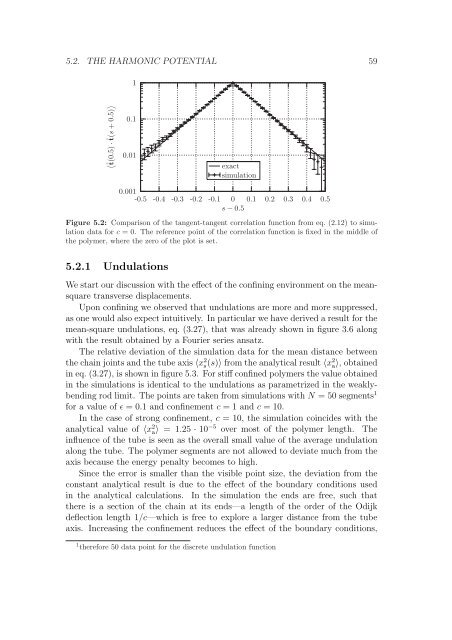Polymers in Confined Geometry.pdf
Polymers in Confined Geometry.pdf
Polymers in Confined Geometry.pdf
You also want an ePaper? Increase the reach of your titles
YUMPU automatically turns print PDFs into web optimized ePapers that Google loves.
5.2. THE HARMONIC POTENTIAL 59<br />
ˆt(0.5) · ˆt(s + 0.5) <br />
1<br />
0.1<br />
0.01<br />
0.001<br />
-0.5<br />
-0.4<br />
-0.3<br />
-0.2<br />
exact<br />
simulation<br />
-0.1 0<br />
s − 0.5<br />
0.1<br />
Figure 5.2: Comparison of the tangent-tangent correlation function from eq. (2.12) to simulation<br />
data for c = 0. The reference po<strong>in</strong>t of the correlation function is fixed <strong>in</strong> the middle of<br />
the polymer, where the zero of the plot is set.<br />
5.2.1 Undulations<br />
We start our discussion with the effect of the conf<strong>in</strong><strong>in</strong>g environment on the meansquare<br />
transverse displacements.<br />
Upon conf<strong>in</strong><strong>in</strong>g we observed that undulations are more and more suppressed,<br />
as one would also expect <strong>in</strong>tuitively. In particular we have derived a result for the<br />
mean-square undulations, eq. (3.27), that was already shown <strong>in</strong> figure 3.6 along<br />
with the result obta<strong>in</strong>ed by a Fourier series ansatz.<br />
The relative deviation of the simulation data for the mean distance between<br />
the cha<strong>in</strong> jo<strong>in</strong>ts and the tube axis 〈x 2 s(s)〉 from the analytical result 〈x 2 a〉, obta<strong>in</strong>ed<br />
<strong>in</strong> eq. (3.27), is shown <strong>in</strong> figure 5.3. For stiff conf<strong>in</strong>ed polymers the value obta<strong>in</strong>ed<br />
<strong>in</strong> the simulations is identical to the undulations as parametrized <strong>in</strong> the weaklybend<strong>in</strong>g<br />
rod limit. The po<strong>in</strong>ts are taken from simulations with N = 50 segments 1<br />
for a value of ɛ = 0.1 and conf<strong>in</strong>ement c = 1 and c = 10.<br />
In the case of strong conf<strong>in</strong>ement, c = 10, the simulation co<strong>in</strong>cides with the<br />
analytical value of 〈x 2 a〉 = 1.25 · 10 −5 over most of the polymer length. The<br />
<strong>in</strong>fluence of the tube is seen as the overall small value of the average undulation<br />
along the tube. The polymer segments are not allowed to deviate much from the<br />
axis because the energy penalty becomes to high.<br />
S<strong>in</strong>ce the error is smaller than the visible po<strong>in</strong>t size, the deviation from the<br />
constant analytical result is due to the effect of the boundary conditions used<br />
<strong>in</strong> the analytical calculations. In the simulation the ends are free, such that<br />
there is a section of the cha<strong>in</strong> at its ends—a length of the order of the Odijk<br />
deflection length 1/c—which is free to explore a larger distance from the tube<br />
axis. Increas<strong>in</strong>g the conf<strong>in</strong>ement reduces the effect of the boundary conditions,<br />
1 therefore 50 data po<strong>in</strong>t for the discrete undulation function<br />
0.2<br />
0.3<br />
0.4<br />
0.5













